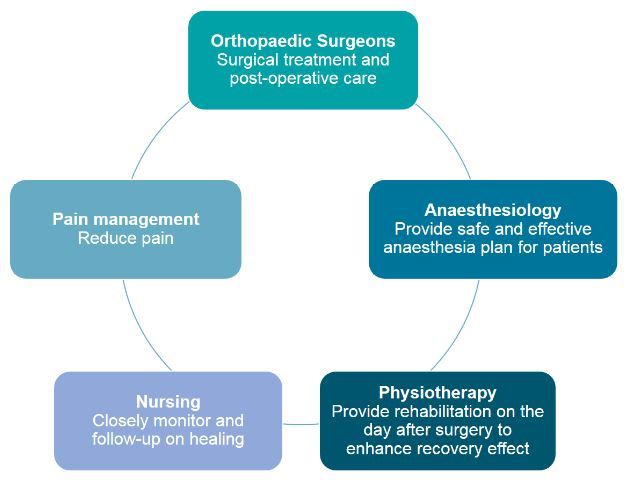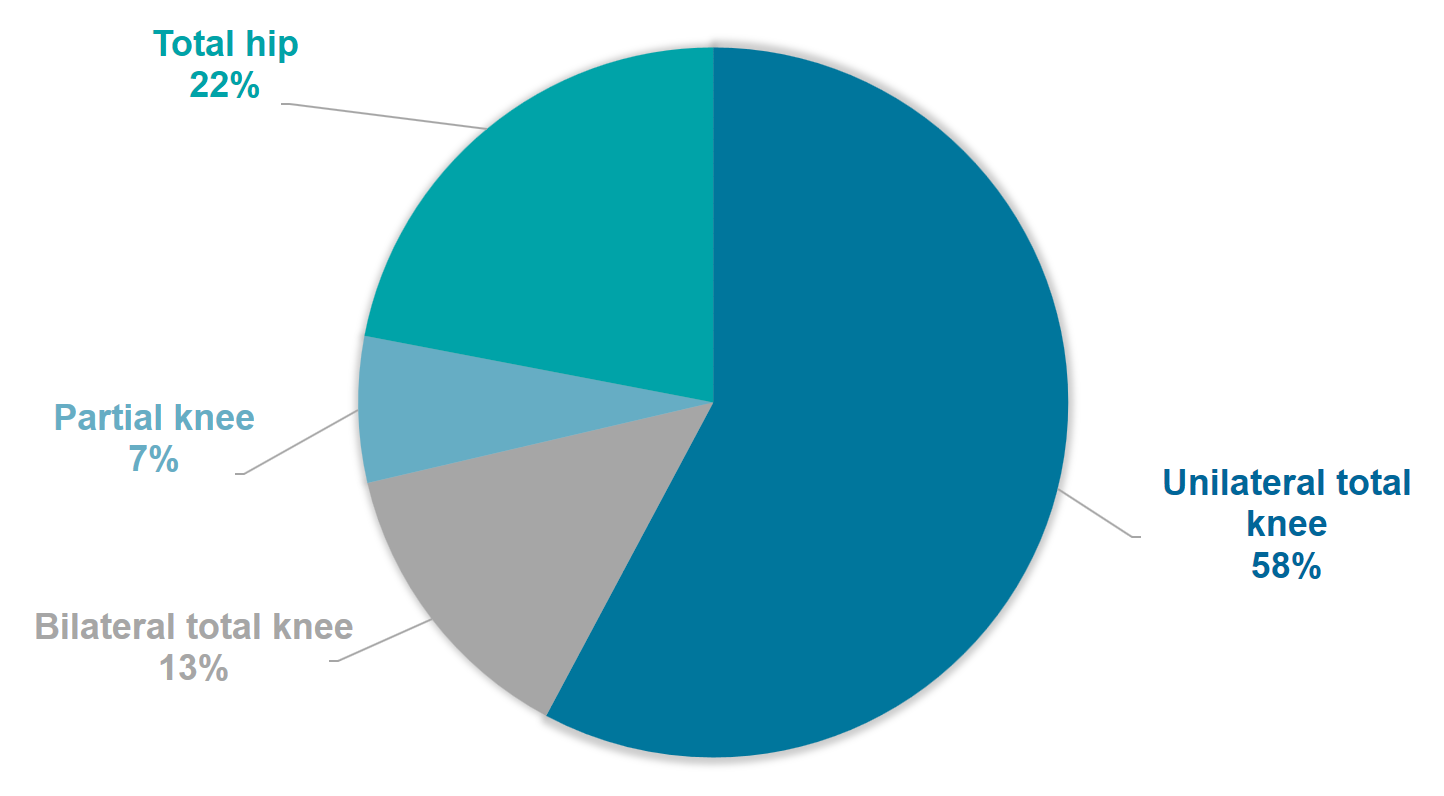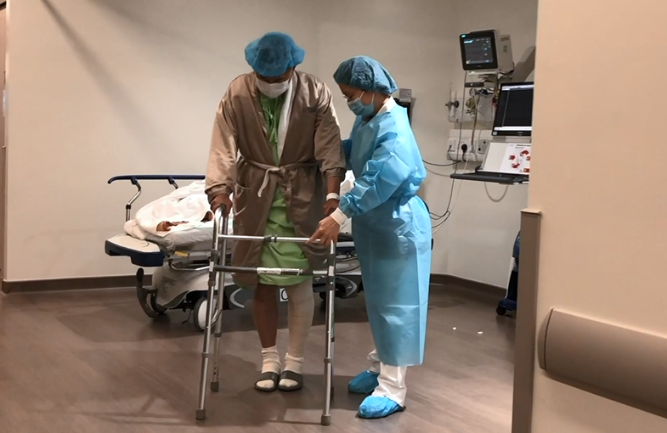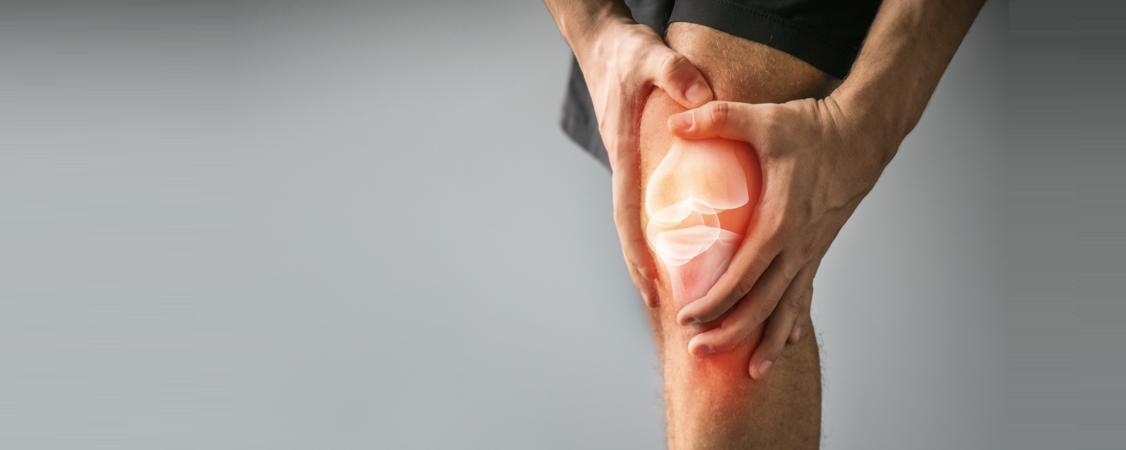Joint Replacement Centre
The Joint Replacement Centre under Orthopaedic Surgery Clinic provides comprehensive care to patients with various joint-related problems or arthritic conditions.
The scope of services includes conservative management, physiotherapy, custom-made braces and orthoses, intra-articular injections, primary and revision total joint replacement surgeries.
The Centre is led by a team of professor and specialists from The University of Hong Kong (HKU). The team has rich experience in joint replacement surgery and Enhanced Recovery After Surgery (ERAS), which results in less pain, earlier mobilisation, quicker recovery and overall improvement in patients’ satisfaction.
The Centre also provides robotic arm-assisted joint replacement surgery which further enhances surgical precision and safety, shortens recovery time, lessens postoperative pain and improves implant survivorship.
The Centre provides all-inclusive and fixed-price medical packages for total hip replacement, total knee replacement, partial (uni-compartmental) knee replacement and robotic-arm assisted total knee replacement (learn more).
Location: Clinic D, G/F, Tower A
Service hours:
- Professor, Joint Replacement Centre
- Every Monday, Tuesday, Thursday & Saturday, 9:00am – 2:00pm (By appointment)
- Specialist
- Monday – Friday, 9:00am – 6:00pm; Saturday, 9:00am – 1:00pm (By appointment)
- Ad-hoc or emergency assessments can be arranged upon request
Our professor and specialists:
- Please view here for information
Consultation fees:
Professor | Specialist | |
Initial | HK$1,090 - HK$2,210 | HK$790 - HK$1,850 |
Follow Up | HK$860 - HK$1,990 | HK$640 - HK$1,400 |
Remarks: The above charges refer to doctor consultation fees only and exclude fees for other procedures, medication, laboratory services, etc. The total charge is subject to the attending doctor's discretion and depends on the patient's condition. Details on ancillary charges are available at the Admission and Cashier Counters.
Common Joint Problem
Arthritis is the swelling and tenderness of one or more of your joints. The main symptoms of arthritis are joint pain and stiffness, which typically worsen with age. The most common types of arthritis are osteoarthritis and rheumatoid arthritis. Osteoarthritis causes cartilage to break down. Rheumatoid arthritis is a disease in which the immune system attacks the joints, beginning with the lining of joints. Uric acid crystals, which form when there is too much uric acid in your blood, can cause gout. Infections or underlying disease, such as psoriasis or lupus, can cause other types of arthritis. Treatments vary depending on the type of arthritis. The main goals of arthritis treatments are to reduce symptoms and improve quality of life.
- Joint pain
- Warmth
- Swelling
- Crackling or clicking sound while moving the joint
- Easy buckling, weakness
- Joint stiffness
- Joint deformity (bow legs)
Treatment Options
- Simple pain killers
- Nonsteroidal anti-inflammatory drugs (NSAID)
- Intra-articular injection of medication e.g. steroid, hyaluronic acid etc
- Reducing pain, strengthening muscles and improving functionality
Traditional Joint Replacement Surgery
- Repairing deformed joints or replacing severely damaged joints
- Surgery should be considered when:
- Reduced quality of life
- Joint stiffness, deformity and reduced mobility
- Joint pain is not effectively controlled by non-surgical methods
Robotic-Arm Assisted Joint Replacement Surgery
- Use of robotic arms allows enhanced preoperative planning, enabling doctors to have a more accurate planning on the size and position of the implant.
- The robotic arm is only active when the surgeon operates within the predefined area, allowing more precision in bone removal and lower risk of injuring surrounding structures.
- With the help of a robotic arm, doctors can better maintain the balance of the ligaments which helps speed up patient recovery
- Biological implants are used in robotic arm-assisted surgeries, resulting in stronger joints and longer service life comparing to traditional artificial joints.
- Tourniquets are no longer needed during robotic-arm assisted surgery thus postoperative pain in patients can be minimised.
- Applicable surgeries*:
- Total knee replacement
- Partial Knee Replacement
- Total Hip Replacement
*In general, most patients with joint problems are suitable for robotic surgery. Please discuss with your doctors to understand the treatment that best suits your condition.
Multidisciplinary Collaboration

Enhanced Recovery After Surgery (ERAS) Approach
- The Centre adopts the Enhanced Recovery After Surgery (ERAS) approach allows patients to be recover and return to normal function as soon as possible
- Pioneered by the HKU Department of Orthopaedics & Traumatology in 2015
- A comprehensive protocol to cover period before, during and after the surgery to reduce bleeding, pain and complication
- Surgeries (total knee replacement, total hip replacement, partial knee replacement) are normally completed within one hour, and patients can walk as soon as one hour after surgery
Advantages
- Speed up functional recovery
- Reduce bleeding and pain
- Reduce complication and mortality
- Increase patients’ satisfaction
- Shorten length of hospital stay
Pre-operative assessment
Gleneagles is currently the only private hospital in Hong Kong that implemented a pre-anaesthesia clinic for total joint replacement patients. Through detailed pre-operative assessments by anaesthesiologists, safe, appropriate and personalised anaesthesia plans and post-operative pain management plans are devised.
Advantages
- Improve patients’ safety
- Minimise anaethetic complications, speed up patients’ recovery after anaesthesia and improve quality of rehabilitation
- Pain management prior to surgery can help reduce post-operative pain
- Provide opportunity for doctor to address patient’s concerns
- Improve patient’s satisfaction
- Minimise cancellation/postponement of surgery due to unfit condition of the patients
Post-operative arrangements
After the surgery, our physiotherapists will arrange rehabilitation programme for the patients. The rehabilitation training can help patients resume their normal lives as soon as possible, reduce risk of complications and reduce the need for routine physiotherapy after discharge.
Multimodal pain management, which helps reduce post-operative pain, enables patient to mobilise as soon as one hour after surgery.
Clinical Outcomes
Joint replacement surgeries performed from June 2017 to May 2020:


- Length of hospital stays
- Unilateral total knee/total hip: 6 days
- Partial knee: 5 days
- Bilateral total knee: 7 days
- Over 97% required no extended hospital stay
- Around 10% patients were discharged early
- Post-operative results
- Average follow-up time
- 11 months [2 weeks – 2 years]
- Post-operative X-rays of all patients showed satisfactory position of the artificial joints
- All patients with total knee joint replacement achieved satisfactory knee joint range and mobility 6 weeks after surgery
- >70% can walk more than 30 minutes
- Average follow-up time
- Early complications in knee joint replacement - Wound healing / fracture
| Gleneagles | Local Public Hospitals (2017) | UK (2019)* | |
| Total knee joint replacement | 0.3% | 1.3% | 0.5% |
| Partial knee joint replacement | 0% | -- | 0.23% |
*Source: 16th Annual Report, National Joint Registry for England, Wales, Northern Ireland and Isle of Man (2019)
- Mid-term and late complications in knee joint replacement - Infection / wound healing / joint dislocation, instability or loosening, and removal and re-implantation
| Gleneagles | Swedish (2019)# | |
| Total and partial knee joint replacement | Middle: 1.9% Late: 0% | 3% |
#Source: Annual Report, Swedish Knee Arthroplasty Registry (2019)
Case Sharing
| Patient | Mr Chan, who is in his 60s |
| Condition before surgery | He started to feel pain in his left knee around 10 years ago. His left knee increased when he walked upslope or climbed stairs. In the recent two years, the situation worsened that he could only walking for 15 minutes even level ground. He found it difficult to get up after sitting for more than half an hour. |
| Diagnosis | Advanced osteoarthritis of the left knee |
| Treatment plan | Total knee replacement with spinal anaesthesia |
| Recovery after surgery | The surgery was successful, and he could walk and started the rehabilitation with the assistance one hour after surgery. He could already walk almost independently and was discharged from Gleneagles four days after surgery. He could resume exercises a few days after returning to home and hike with friends on outlying islands, enjoy outdoor activities, and work as usual in less than one month after surgery. |
 |  |
| One hour after surgery | The fourth day after surgery |
What our patients say

醫生及5B病房各位姑娘員工等:
本人在手術住院期間,多得各位醫生專業高超技術,治好膝患,康復進展良好。
醫者們的熱誠及愛心、關懷,令我銘記於心。僅此致上衷心祝福,
祝工作愉快,身體健康!
(並多謝物理部各姑娘。)

本人選擇於港怡醫院接受全人工膝關節置換手術全因初診時醫生詳細且盡心解釋,以及本人丈夫對港怡的信心。
深深感激醫生的幫助並替本人做手術。手術後第二天,得到物理治療師的指導和幫助,本人已能下床步行,真的不敢想像,我真的能做到,令本人丈夫對醫生的高明醫術敬佩不已。
我左腳膝頭的疼痛問題已出現十年,走路15分鐘就會開始疼痛,對生活造成困擾。幸好朋友向我介紹港怡醫院的醫生,安排全膝關節置換手術。手術後沒有太大疼痛感,一個小時後已嘗試走路,想不到能從手術室走回病房!感謝港怡醫院的醫生、護士及物理治療師在我住院四天期間的照顧,令我康復進度良好,很快便回復正常生活,還可以到離島遊玩。






